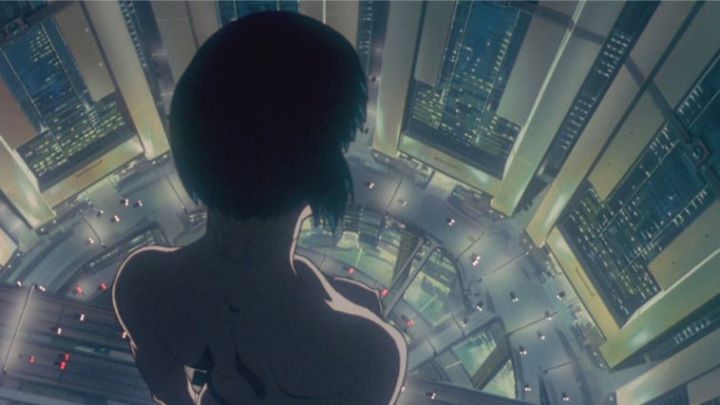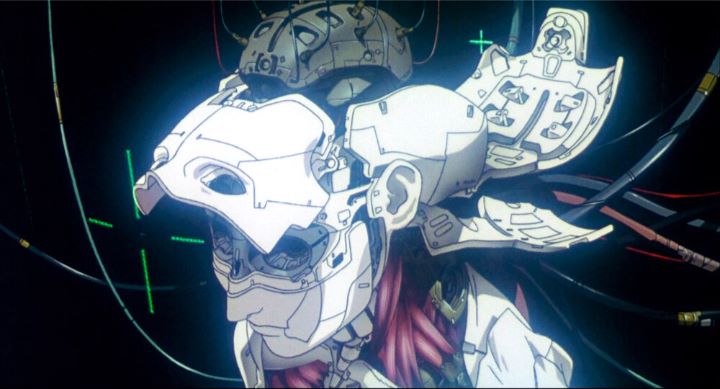








Disclaimer: this review covers both the original 1995 film and (briefly) the 2.0 re-release from 2008.Ah yes, "Ghost in the Shell." The 1995 film stands as one of the most influencial anime films of history, with only a rival in the 1988 film "Akira." "Ghost in the Shell" was cyber-punk, was forward-thinking, was revolutionary. This was owed both to the original manga, and to the film's director Mamoru Oshii, whose thick and philosophical style became acclaimed the world-over for this single movie. At the core of the movie is one basic question: "Can machines be alive?" From that branches other questions: "What does it mean to be alive?" "What does it mean to be a machine?" Technically, this type of question has been seen before in science-fiction. Look up "Blade Runner" or the books of Issac Asimov for just a few examples. But those too are influencial beyond most works of modern art. And it's rarely seen with such thoughtful discussion in a cartoon. Yes, sci-fi pulp with extreme violence, sex and profanity was common in anime even then. But in "Ghost in the Shell," we had a film that catered to those tastes in a mature manner, feeling like something would could share with non-anime-initiated to explain our appreciation for the medium. However, taken with a fresh and modern perspective, the appeal of the movie isn't as strong as it used to be. Much of the world-changing ideas have been copied many times over, often better and more refined. "Ghost in the Shell" as a property has spawed multiple anime films, television shows, and most recently a Hollywood adaptation. And almost all of the adaptations tread the same ground with the same characters, similar storylines with mandatory iconic poses and action shots. If I were to show the original classic film to a 15-year old who had never heard of it, I would not be offended if they were to finish it and ask "what's the big deal?"The story drops us into Makoto Kusanagi's world, a future where robots and androids and common, but the streets are still dingy and crime is still present. Human augmentations are an every-day occurance, be it for function or fashion. Makoto herself is a secuity agent working for Section 9, a special person in that her entire body is artificial: only her brain remains from her original body. As they begin to investigate a series of crimes carried out by "The Puppet Master," the antagonist asks questions that are especially hard for Makoto: with only a brain, is she still really human? Would she be human without the brain? Are there memories or feelings she once had, now missing without her knowledge?It's fun to think about to an extent, even if no answers are ever given. Oshii has a tendancy to go overboard with topics that don't carry well into film, but thankfully the pacing in "Ghost in the Shell" isn't horrible, thanks to a handful of memorable action set-pieces. Even still, it can be slow, perhaps too slow for most people. And the ending, while poigniant, closes off the franchise from sequels, even know Oshii attempted a sequel film after the success of the first. Aside from not quite retaining its fresh appeal (although the story is still very good), the animation also doesn't age particularly well. Some basic use of CGI is attempted to blend with the 2D animation, but at the time such technology was rare in anime, and machines weren't powerful enough to make the most of it. The old-school 2D animation looks old, and not always in a good way. I will give credit to the character designs for being memorable, even if Makoto's pale muscular body and non-expressive face is a strange thing to look at. The animation is best during the quiet moments up to and including the action scenes, of which I can count on one hand, but were impressive for its time and would give Production I.G. a high reputation for decades.The musical score is probably the best part of the original film, using a distinct and haunting chant as its main theme by Kenji Kawai. The English dub and Japanese dubs are both dull, a side-effect of the story content and the director's personal style, despite the other benefits each bring. While both versions are more easily available now, there was a time when the 1995 release was out of print, and only the "2.0" version could be found. Not to be confused with "Ghost in the Shell 2 - Innocence," "Ghost in the Shell 2.0" is most distinct in its updated visuals, largely meant to better mesh with the style produced in "Innocence." This includes a lot more CGI, some replacing entire iconic scenes, and a redone-color tone to make the film appear more orange and brown instead of the original green and blue. This is commonly compared to George Lucas' treatment of the original Star Wars trilogy, where digital formats of the film were completely redone with the latest technology, removing the original puppetry at work. But while the CGI can be distracting (and quickly looked out of date even a few years later), the film is still very much watchable, and in some ways the update does improve the original's aging style. You will likely have a personal preference, but don't throw away one or the other for ignorance."Ghost in the Shell" is still considered a classic for good reason, and still stands as a good movie better than most other "classic" anime. It is still very much essential to watch, even if the urgency to do so has diminished.
Aside from not quite retaining its fresh appeal (although the story is still very good), the animation also doesn't age particularly well. Some basic use of CGI is attempted to blend with the 2D animation, but at the time such technology was rare in anime, and machines weren't powerful enough to make the most of it. The old-school 2D animation looks old, and not always in a good way. I will give credit to the character designs for being memorable, even if Makoto's pale muscular body and non-expressive face is a strange thing to look at. The animation is best during the quiet moments up to and including the action scenes, of which I can count on one hand, but were impressive for its time and would give Production I.G. a high reputation for decades.The musical score is probably the best part of the original film, using a distinct and haunting chant as its main theme by Kenji Kawai. The English dub and Japanese dubs are both dull, a side-effect of the story content and the director's personal style, despite the other benefits each bring. While both versions are more easily available now, there was a time when the 1995 release was out of print, and only the "2.0" version could be found. Not to be confused with "Ghost in the Shell 2 - Innocence," "Ghost in the Shell 2.0" is most distinct in its updated visuals, largely meant to better mesh with the style produced in "Innocence." This includes a lot more CGI, some replacing entire iconic scenes, and a redone-color tone to make the film appear more orange and brown instead of the original green and blue. This is commonly compared to George Lucas' treatment of the original Star Wars trilogy, where digital formats of the film were completely redone with the latest technology, removing the original puppetry at work. But while the CGI can be distracting (and quickly looked out of date even a few years later), the film is still very much watchable, and in some ways the update does improve the original's aging style. You will likely have a personal preference, but don't throw away one or the other for ignorance."Ghost in the Shell" is still considered a classic for good reason, and still stands as a good movie better than most other "classic" anime. It is still very much essential to watch, even if the urgency to do so has diminished.